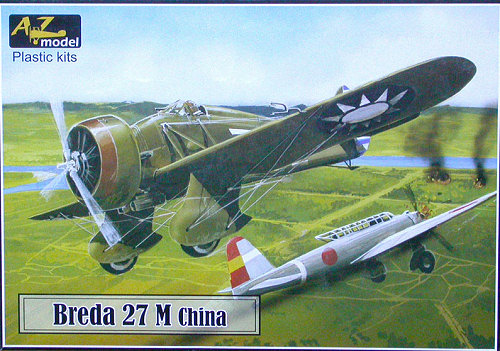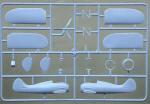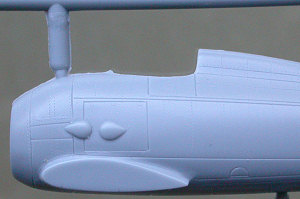
| KIT: | AZ Model 1/72 Breda 27M |
| KIT #: | AZ 7201 |
| PRICE: | $ |
| DECALS: | Two options |
| REVIEWER: | John Brouwer |
| NOTES: | Short run mulitmedia kit |

| HISTORY |
If you think that you are looking at a box top depicting a Boeing P-26 painted up in Chinese colours you are forgiven. In fact it is a Breda 27 M (M for metallico) 11 of which were produced for China and delivered in 1936 although 18 had been ordered.
The 27 M prototype served with the Italians until 1937. The first two Breda 27 prototypes were of mixed metal and wood but were not successful and a redesign produced the 27 M, in the meantime being influenced by the above-mentioned P-26.
Go here for a discussion about them. http://www.airwarfareforum.com/viewtopic.php?t=4629
Interestingly China also received 11 Boeings after they became surplus in the USA (sometimes stated as newly built ). I suspect that some of the reports on the use of the P-26 in China would actually be reporting the Breda, as they would look identical in the air.
| THE KIT |

 This
is the first (AZ 7201) in an injection moulded extension to the line of Czech
resin kits under the Legato banner. The resin parts included have the Legato
logo on them. The PE parts are Eduard and the decals Tallyho. These are both
of recognised and well-known quality. The instructions are by H-Models and are
very similar to RS Model kits, also a small Czech producer. The Breda
instructions are printed on glossy paper!
This
is the first (AZ 7201) in an injection moulded extension to the line of Czech
resin kits under the Legato banner. The resin parts included have the Legato
logo on them. The PE parts are Eduard and the decals Tallyho. These are both
of recognised and well-known quality. The instructions are by H-Models and are
very similar to RS Model kits, also a small Czech producer. The Breda
instructions are printed on glossy paper!
In the instructions parts colours are indicated, viz. red-brown, light-grey etc. The rear of the box has 2 sets of colour 2 views, which refer to Humbrol and Agama numbers.
There are 2 schemes both very simple, one all over green the other with blue on the under surfaces.
The decals are also few and simple, Chinese markings and a fin flash and 2 different numbers.
The resin parts (6) are in grey and to a good standard although there are a few surface pin -pricks and one of the spats has a large internal bubble which I will need to fill, as it is fragile as is (does Legato pressurise while the PU sets? A sure fire way of avoiding bubbles).
The injected parts are in a single frame with slight flash only near the gates.
 There is slightly raised
wing and tail-plane rib detail otherwise refined scribed panel lines and some
very fine scribed rivet detail which will be difficult to retain under paint
(see detail pic) so should not cause concern to those objecting to too much
surface detail! There is some internal bracing depicted inside the cockpit
area. Some of the PE parts complement this and PE seatbelts and an instrument
panel are also there. All joints are butt ones including wings and tail
planes. Overall, I was impressed with the level and quality of the detailing as
well as the good-looking mouldings generally.
There is slightly raised
wing and tail-plane rib detail otherwise refined scribed panel lines and some
very fine scribed rivet detail which will be difficult to retain under paint
(see detail pic) so should not cause concern to those objecting to too much
surface detail! There is some internal bracing depicted inside the cockpit
area. Some of the PE parts complement this and PE seatbelts and an instrument
panel are also there. All joints are butt ones including wings and tail
planes. Overall, I was impressed with the level and quality of the detailing as
well as the good-looking mouldings generally.
The windscreen is provided as a printed sheet of clear Mylar that has to be folded up and a separate piece of PS rod (not provided) inserted as the gun sight.
Wing and tail plane bracing is specified as either 0.3 or 0.4 mm diameter stretched sprue. As a PE part (centre span brace) has to be attached to some of it wire might be better and Iíll be using that. Guitar string is always a good choice here for constant and repeatable diameters.
| CONCLUSIONS |
Not really a beginners kit given the PE parts and the bracing wires but on the other hands parts are few and the colour schemes are certainly not difficult!
This kit is available from some of the specialist retailers in Germany, the Czech Republic or Italy. I havenít yet noted a US outlet. They also do the prototype version. Price is around Euro 12. Worth keeping an eye open for their forthcoming interwar aircraft .
February 2007
| REFERENCES |
More on the Breda a/c here http://www.ilvolo.net/scat_aer_ita_breda27.htm And go here, http://en.wikipedia.org/wiki/Chinese_armies_in_the_Second_Sino-Japanese_War for a list of the equipment used in the Sino - Japanese war, a surprisingly long and interesting one.
If you would like your product reviewed fairly and quickly by a site that has nearly 350,000 visitors a month, please contact me or see other details in the Note to Contributors.